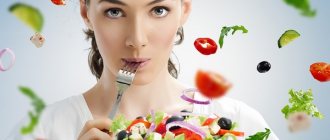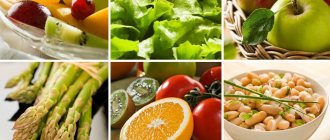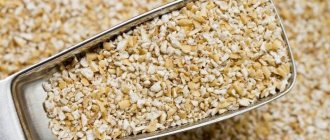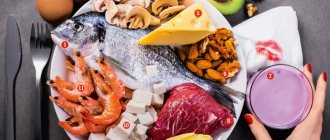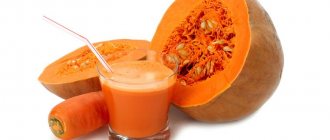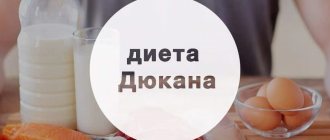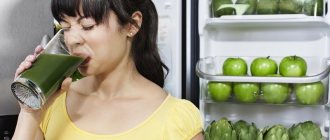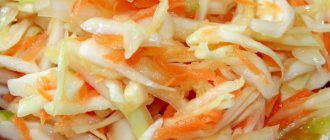The main question among people involved in sports is how to lose weight while maintaining muscle and without compromising the intensity of training? A nutrition system has been developed that is recommended by nutritionists and trainers - protein-carbohydrate alternation, or BUC for short. What's the secret? Let's figure it out together!
Increasingly, protein-carbohydrate alternation is used for weight loss among athletes and nutrition-conscious people. This technique eliminates subcutaneous fat by alternating foods rich in proteins and carbohydrates.
At the same time, the body’s daily need for energy and nutrients is fully satisfied, so the feeling of hunger does not appear on the diet. Excess weight slowly but surely disappears forever.
In this article you will learn:
- how the protein-carbohydrate alternation diet works and the presence of contraindications;
- classical approaches to constructing cycles on BEACH and the possible duration of the diet;
- how to create a menu for a protein-carbohydrate diet and examples of recipes.
Basic principles of protein-carbohydrate alternation
If there is more energy received from food than consumed per day, the body stores the excess as fat. An excessive calorie deficit, which those losing weight create in the early stages and enjoy rapid weight loss, leads to loss of water and muscle mass. This happens because nutrients from muscle fiber are more accessible than fat reserves.
As soon as the body realizes that there is nothing left to get from the muscles, only then the hated kilograms are used. This explains the phenomenon where a long and strict diet leaves a high percentage of subcutaneous fat in the body, despite a low overall body weight.
A diet based on the BEAM principle misleads the body:
- Protein days are stressful but provide enough nutrients to maintain muscle tissue. Energy consumption occurs due to “strategic reserves” of fat;
- prolonged stress is perceived by the body as a threat and activates the preservation of fat depots, but carbohydrate days come into play. As a result, there are no stress factors, metabolism does not slow down;
- return to protein days and further in a circle.
Using the method, you can deceive the body and not slow down your metabolism, burning extra pounds. Another advantage is the preservation and development of muscle mass, since the tissue is not consumed to nourish the body.
What data is needed for calculations
Do not use other people’s calculations; calculate the daily norm of KBJU specifically for yourself. You will need the following data:
- age;
- floor;
- lifestyle (sedentary, active, heavy physical activity, etc.);
- metabolism;
- Goal: lose weight, gain weight, maintain body weight.
How to calculate KBJU once? It is impossible to calculate the norm of KBZHU and use it all your life. The initial data will change and the norm will change along with it. Carry out calculations at least once a year, the success of the final goal depends on it.
Effect on the body
A balanced and delicate protein-carbohydrate diet for weight loss with a rich menu gives a signal to the body to burn its own fat reserves without the feeling of hunger and exhaustion. What happens in the process:
- burning fat without using muscle fibers. The body becomes embossed;
- losing weight on protein days;
- carbohydrate days replenish energy reserves, provide strength and prevent depression, and maintain performance;
- the body receives important macroelements, so hair, nails, skin and health do not suffer;
- A variety of food enters the stomach, so there is no getting used to a certain set of foods.
The most important thing is the absence of stress for the central nervous system and a full menu with useful microelements, so a protein-carbohydrate diet maintains the health of those losing weight without affecting the quality of life.
What it is?
Macronutrients are substances that are vital for the body, all its systems and organs. These include:
- Proteins or proteins are substances involved in all processes occurring in the body. They act as “building material” for cells, tendons, and tissues. Proteins consist of enzymes responsible for the regulation of metabolism, hormones, antibodies, and hemoglobin. Protein deficiency is dangerous to health and can provoke the development of diseases of the circulatory system, liver, and gastrointestinal tract.
- Fats are part of cell membranes and perform an important protective function, protecting the body from the penetration of pathogenic bacteria and providing thermoregulation. With moderate consumption, fats will not lead to weight gain, and their deficiency, on the contrary, can cause the development of atherosclerosis and cardiovascular diseases.
- Carbohydrates are a fairly broad class, represented by a huge number of foods rich in vitamins, minerals, fiber and plant fibers.
Let's take a closer look at the role of each of the listed macronutrients for weight loss.
Disadvantages of the BUCH system
The system of alternating proteins and carbohydrates is used mainly by athletes, but even supporters of iron sports avoid training for a number of reasons:
- Difficulty of nutrition: even if you follow the principles of protein-carbohydrate alternation, the menu must be systematically adjusted to make weight loss easy. Before you decide on a nutritional scheme and plan in the percentage of proteins, fats and carbohydrates, you will need to try the method several times;
- psychological preparation: not many people can have the patience and time to prepare a diet specifically for a low-carb or high-carb day;
- change in indicators: weight loss occurs in two days, and weight gain occurs in one day. If you get carried away with carbohydrates during the loading phase, weight gain will show up on the scale.
Daily calculation of BZHU
For those new to proper weight loss and those who have decided to switch to a healthy diet, it can be difficult to understand food intake and calories. In fact, you will quickly remember a list of healthy foods and be able to determine your daily menu. To make the initial calculations easier, keep in mind: one gram of carbohydrates and proteins contains 4 kcal, and 1 g of fat contains 9 kcal.
Remember that nutrition should be complete - contain the maximum amount of various vitamins and minerals. To support the body, you can take a course of multivitamin complexes, but only after consultation with an endocrinologist or nutritionist.
Channel about healthy lifestyle in telegram! Subscribe
Detailed description of the BUTCH diet
Calculations are based on dry weight, that is, without fat. Consider the classic 2-1-1 protein-carbohydrate nutrition scheme:
- Day 1 – protein: protein is consumed at the rate of 3 g per 1 kg of weight. Carbohydrate products are not consumed. The exception is fiber contained in green vegetables in the amount of 50 g of carbohydrates (not product);
- Day 2 – protein: identical to the first day;
- Day 3 – carbohydrate: the amount of protein is reduced to 1.5 g per 1 kg of weight, and carbohydrates are calculated from the ratio of 4 g per 1 kg;
- Day 4 – mixed: a day of proper nutrition balanced in proteins and carbohydrates.
It is important that the calculated daily calorie intake for weight loss is not exceeded on high-carbohydrate days, so you should carefully monitor the food you eat.
On a protein-carbohydrate diet, the main thing is to choose the right source of energy on each day.
Calculation example
A 92 kg man with a body fat percentage of 18%, actively involved in sports 3 times a week. The average kilocalorie consumption on training days is 3000-3500. On non-training days 2000-2500. Net weight – 75 kg.
Based on this, on a carbohydrate-free day its calorie content will be calculated as:
- 75*3 – 225 g protein – 924 kcal.
- 30-50 g of green carbohydrates (less if possible) – 123 kcal.
- 5-10 g omega 6 fats – 92 kcal.
The total calorie intake is 1140 kcal on a carbohydrate-free day. The total kilocalorie deficit is about 2000 kcal per training day. Standard cycle BUCH – 4/1.
On the day of loading, his meals should be:
- 75 g protein – 308 kcal.
- 5-10 g omega 6 fats – 92 kcal.
- Total calorie content is 3500-3850 kcal.
- This means that the remainder falls on carbohydrates - up to 700 g of carbohydrates. Mostly complex.
The total weekly kilocalorie deficit is about 4000-5000 kcal. When converted to adipose tissue, this amounts to 444 hectares of fat per week. 0.44 kg of 17 kg body fat is about 2.5% of body fat weekly, or 10% of body fat loss per month. Those. at the end of the month, the man will have lost 89-90 kg, having reduced the body fat to 17.2%.
Attention: after seeing the calculations, many will consider the result low. However, keep in mind that the example used was an athlete with a small amount of body fat (about 18%).
For people with a higher fat ratio, weight loss will be more significant. So, for example, for a person weighing 92 kg, with a fat ratio of about 35%, weight loss per month will be about 6-7 kg. This once again confirms the fact that the diet is intended for pure cutting (reducing fat while preserving muscle), and not for pure weight loss, in which all tissues are burned.
Authorized Products
The list below will make it easier to compile a grocery basket:
Squirrels
Lean protein ingredients do not contain many calories, which allows you to consume large portions of the finished dish:
- low-fat dairy products: kefir, cottage cheese, yogurt without additives, milk, fermented baked milk, hard cheese;
- fish: pollock, tuna, pink salmon, flounder;
- seafood: without exception;
- meat: beef, veal, rabbit;
- poultry: chicken and turkey fillet without skin;
- legumes: chickpeas, lentils, beans;
- chicken, quail egg;
- nuts.
Carbohydrates
During BEACH, only complex carbohydrates are used, and during the carbohydrate day, fruits are added:
- vegetables and greens (except potatoes, pumpkin);
- fruits (except banana, grapes);
- bread and pasta made from durum wheat;
- cereals: oatmeal, buckwheat, brown rice.
Fats
It is permissible to season salads with unrefined vegetable oils and additionally consume fish oil.
Prohibited Products
To create a menu, the diet contains a number of restrictions so that alternating protein and carbohydrate days brings maximum results:
- high fat dairy products;
- fatty meats: pork, lamb;
- sausages;
- margarine, spread, butter;
- fatty fish: herring, halibut, sturgeon, etc.;
- canned food;
- sugar and sugar-containing products;
- soda, packaged juices;
- chocolate, confectionery, baked goods;
- fast food.
Duration
A diet with alternating protein and carbohydrate days can be long-term, but for this it is important not to have any deviations in health. To begin with, a cycle of 8 days is suitable to track your well-being and find out the body’s capabilities. And then alternate proteins and carbohydrates for 21 days or more. For a long period of time, it is imperative to control sufficient fat intake.
A balanced diet allows you to maintain BCH for up to 2-3 months, however, nutritionists recommend taking breaks between cycles for 1-2 months.
Oatmeal in a jar
Suitable for a carbohydrate day. To do this you will need:
- 2/3 cup oatmeal;
- the same amount of milk;
- 1 tbsp. l. berry jam;
- any seasonal or frozen berries (to taste).
Preparation:
- All ingredients are mixed in a jar, preferably glass, with a screw cap.
- Leave overnight in the refrigerator.
In the morning the dish is ready to eat.
Contraindications
Contraindications to the use of BCH are:
- pregnancy and breastfeeding;
- kidney disease, gastrointestinal tract, genitourinary system;
- cholelithiasis;
- individual intolerance to the proposed products.
Nutrition organized according to the principle of alternation requires self-organization and control from those losing weight. At the slightest ailment or in case of illness, you should return to your normal diet and focus on health, not weight loss.
Sample menu for the week
The diet helps you lose 0.5 to 3 kg per week, depending on your initial weight. Extra pounds do not go away as quickly, since muscles are heavier than fat. It is recommended to focus on body volumes and take measurements using a centimeter.
To adjust protein-carbohydrate alternation to individual needs, we offer a weekly menu designed for 2 alternation cycles. For a longer period, it is necessary to duplicate the days, maintaining the sequence.
| Mixed DAY: | |
| Breakfast | Cottage cheese with berries, coffee with cream |
| Lunch | Green or yellow apple |
| Dinner | Lentils, chicken broth and a piece of chicken fillet |
| Afternoon snack | Whole grain bread and a glass of tomato juice |
| Dinner | Boiled beef and stewed cabbage |
| Protein DAY: | |
| Breakfast | Protein omelet and herbal tea without sugar |
| Lunch | Any citrus |
| Dinner | Spinach soup and boiled eggs |
| Afternoon snack | Kefir |
| Dinner | Chicken cutlets with broccoli |
| Protein DAY: | |
| Breakfast | Cottage cheese casserole and unsweetened coffee with milk |
| Lunch | Kiwi |
| Dinner | Salmon in milk |
| Afternoon snack | Yogurt without additives |
| Dinner | Egg salad with avocado |
| Carbohydrate DAY: | |
| Breakfast | Oatmeal with pieces of fruit and honey, tea with honey |
| Lunch | Pears |
| Dinner | Sweet potato with yogurt |
| Afternoon snack | Dates |
| Dinner | Vegetable salad with quinoa |
| Mixed DAY: | |
| Breakfast | Cheesecakes with honey, coffee with cream |
| Lunch | Banana |
| Dinner | Seafood soup |
| Afternoon snack | Yogurt without additives |
| Dinner | Baked fish with vegetable salad |
| Protein DAY: | |
| Breakfast | Boiled egg whites, unsweetened herbal tea |
| Lunch | Citrus |
| Dinner | Egg soup with fish |
| Afternoon snack | Ryazhenka |
| Dinner | Turkey and grilled vegetables |
| Protein DAY: | |
| Breakfast | Omelet with shrimps, coffee without sugar with milk |
| Lunch | Green apple |
| Dinner | Cottage cheese with yogurt without additives |
| Afternoon snack | Curdled milk |
| Dinner | Green salad dressed with oil |
| Carbohydrate DAY: | |
| Breakfast | Rice porridge with raisins, coffee and bread |
| Lunch | Banana |
| Dinner | Noodles soup |
| Afternoon snack | Bakery product made from durum flour |
| Dinner | Potato dumplings |
Meals can be swapped. The main rule is to observe alternation.
Menu for 21 days
Products shown are exemplary. Each product on the menu is replaced every day with ingredients similar in macronutrient content.
| № | Type of days | Breakfast | Dinner | Dinner | Snacks |
| 1 | Protein | Low-fat cottage cheese | Fish baked with vegetables | Egg white omelette | Steamed fish or vegetables |
| 2 | Protein | Grilled veal, vegetables | Chicken with Chinese cabbage salad | Low-fat cottage cheese | Egg or seafood |
| 3 | Carbohydrate | Rice porridge with milk and raisins | The vinaigrette | Omelette in the oven with quinoa | Orange or pear |
| 4 | Mixed | Oatmeal with water and nuts | Seafood pilaf | Boiled chicken breast and green salad | Apple or steamed vegetables |
| 5 | Protein | Fried fish without oil | Chicken breast and green beans | Skim cheese | Eggs or grilled vegetables |
| 6 | Protein | Omelette | Fresh vegetable salad and seafood | Baked fish | Low-fat cottage cheese |
| 7 | Carbohydrate | Hard pasta with hard cheese | Buckwheat with mushrooms | Boiled chicken breast with vegetables | Grapes or berries |
| 8 | Mixed | Millet porridge, boiled eggs | Brown rice and boiled beef, vegetable salad | Omelette | Fruit or vegetable salad |
| 9 | Protein | Grilled fish, broccoli | Omelette with vegetables | Low-fat cottage cheese | Eggs or shrimp |
| 10 | Protein | Chicken breast in the oven with vegetables | Low-fat cottage cheese | Boiled beef with herbs, cucumbers | Egg whites or steamed fish |
| 11 | Carbohydrate | Buckwheat porridge with milk | Oatmeal with fruit | Low-fat cottage cheese | Banana or dried fruits |
| 12 | Mixed | Oatmeal with berries | Durum pasta, salad, chicken breast | Egg omelet | Citrus |
| 13 | Protein | Fried veal without oil | Steamed fish cutlets with cabbage | Boiled chicken breast, green beans | Eggs or vegetable salad with avocado |
| 14 | Protein | Omelette | Chicken with eggplant | Stewed cabbage with chicken breast | Low-fat cottage cheese |
| 15 | Carbohydrate | Rice porridge with apple and cinnamon | Vegetable soup, whole grain toast with cheese | Barley with fresh vegetable salad | Banana or citrus fruits |
| 16 | Mixed | Pilaf with seafood | Low-fat cottage cheese with berries | The vinaigrette | Pear or eggs |
| 17 | Protein | Steamed beef with herbs | Chicken breast baked with cauliflower | Omelette in the oven | Grilled vegetables or fish |
| 18 | Protein | Fish baked with carrots | Chicken with green beans | Low-fat cottage cheese | Eggs or hard cheese |
| 19 | Carbohydrate | Millet porridge with milk and pumpkin | Buckwheat with mushrooms | Vegetables with eggs | Low-fat cottage cheese |
| 20 | Mixed | Oatmeal porridge with dried fruits and nuts | Chicken with mixed vegetables | Fish soup | Low-fat cottage cheese or omelette |
| 21 | Protein | Omelette with seafood | Chicken broth with broccoli | Low-fat cottage cheese | Fish or stewed vegetables |
Learn more about the BUTCH diet in the video.
And let’s look at the important aspects of ending the period of protein-carbohydrate alternation and examples of recipes.
Omelette with green beans
Suitable for a protein day. Need to:
- 2 eggs;
- half a glass of milk;
- green beans (no matter, for one serving).
Preparation:
- The proteins are separated.
- Beat them with milk.
- Pour this mixture over lightly fried green beans in butter.
- Cook in the oven for 10 minutes.
You need to exit the BUTCH diet wisely. In no case should you increase the volume of portions and calorie intake immediately after it ends. During this entire time, you need to maintain the correct drinking regime - at least 2 liters of clean water per day.
Quitting the diet
As soon as the desired result is achieved, there should be no “belly celebration”. In addition to the return of lost pounds, serious health problems may arise due to overload of the stomach and digestive system as a whole.
To avoid negative consequences, it is necessary to ensure a smooth exit from the BUCH. Nutritionists recommend:
- gradually increase the amount of fatty foods (fish, dairy products, meat);
- increase the portion of carbohydrates by 50 g daily;
- Continue to monitor your calorie intake.
After returning to a normal diet, it is recommended to adhere to proper nutrition and get the necessary macro and microelements for the body to function properly - this will allow you to keep your figure toned and sculpted for a long time.
Recipes
The advantage of a protein-carbohydrate diet is the variety of products and possibilities in preparing dishes. A few recipes to note.
Pancakes with curd
carbohydrate and mixed day
Preparation method:
- Pancakes: mix all ingredients so that there are no lumps.
- Fry the pancakes on both sides for 2-3 minutes in a hot non-stick frying pan without adding oil.
- The cottage cheese should be soft. Grease the pancake and roll it into a roll.
*Can be served with berries or fruits.
Ingredients: - rice flour 100 g; — chicken egg – 2 pcs.; — milk 1.5% — 50 ml; – hot water – 50 ml; - for filling - cottage cheese 1.8% - 150 g.
Protein soup with spinach
protein day
Preparation method:
- Boil the turkey, remove and cool. Grind and place back into the broth.
- Chop the spinach, add to the meat and cook for 10 minutes over medium heat.
- Puree the finished soup in a blender with garlic, gradually adding milk. Sprinkle with spices.
* Served hot.
Ingredients: - turkey fillet - 400 g; — fresh or frozen spinach — 100 g; - garlic - 2 cloves; — milk 0.5% -100 ml; - seasonings to taste.
Chicken nuggets in bran
protein day
Preparation method:
- Rinse the chicken fillet and pat dry on a paper towel. Cut into small nuggets and beat.
- Beat eggs with bran and spices.
- Dip the nuggets in the batter and place in a baking dish.
- Pour the remaining batter over the meat and place in an oven preheated to 180 degrees for 25-30 minutes.
Ingredients: - chicken fillet - 500 g; — oat bran – 40 g; — chicken egg – 2 pcs.; - spices - to taste.
carrot cake
carbohydrate day
Preparation method:
- Cakes : grate the carrots on a fine grater, mash the banana with a fork.
- Beat the eggs into a light foam, add to the carrots, stir.
- Using an immersion blender, blend the mixture until smooth.
- Add the remaining ingredients and mix with a spoon.
- Divide the dough into two parts, bake the cakes separately in an oven preheated to 180 degrees for 30 minutes. Cool completely.
- Cream : beat everything with a mixer, coat the cooled cakes and tops.
- Place in the refrigerator overnight.
Ingredients for two cakes: - chicken egg - 4 pcs.; – grated carrots – 200 g; — corn flour – 120 g; - oatmeal - 120 g; – banana – 150 g; - cinnamon - ½ tsp; - soda - 1 tsp. Cream: - cottage cheese 1.8% - 150 g; – lemon juice – 25 ml; - sweetener - to taste.
Following the periodization of protein-carbohydrate alternation will help achieve good results in losing weight while maintaining muscle mass. Careful study of the material, self-discipline and self-confidence are a serious requirement for success!
Proteins, fats and carbohydrates - what is their function?
Nutrients perform vital work for the body, supplying useful elements in sufficient quantities. If we only drank water and took vitamins and microelements from dietary supplements, our internal systems would stop developing.
The listed substances have practically no independent calories, despite the fact that together they complement the nutritional value of the products.
Without BJU and fiber, our body experiences an acute nutritional deficiency. Accordingly, this slows down all internal processes and stops the formation of muscle and other tissues.
For this reason, nutritionists do not recommend long-term fasting. For example, eat only fruits or “sit” on kefir for a month. Like all living things, the body needs balance.
Squirrels
The main element for building muscles and supporting the immune system. If the body experiences a deficiency of fats and carbohydrates, proteins take on the energy function. Why is this bad: protein synthesis is disrupted, and everyone feels the failure - the immune system weakens, swelling appears, and muscles disappear.
Excess is also not a gift, since the risk of protein poisoning, kidney failure and increased calcium output increases (excessive protein diet during pregnancy is a risk of pathologies in the child).
What food to get proteins from:
- eggs (chicken, goose, etc.);
- meat (not to be confused with semi-finished meat products in the form of sausages);
- cheese, milk and other fermented milk products;
- Fish and seafood;
- lentils, chickpeas and other legumes.
It is important to combine the source of proteins, not limiting yourself to turkey meat or pollock. It is optimal to combine plant and animal proteins to obtain various excipients.
What are the benefits of proteins:
- maintain muscle tone and promote their growth;
- improve the condition of blood vessels;
- in childhood they are responsible for growth function;
- strengthen immune defense;
- makes hair and nails strong.
The optimal daily proportion of plant and animal proteins is 55:45 (this is approximately 100 g of protein food daily).
What threatens the lack of proteins: If a long-term deficiency occurs, the system turns to the muscles and cells, “pulling” the necessary substances from them, which leads to functional disruptions in the functioning of the thyroid gland, gonads, and adrenal glands.
Unlike fats and carbohydrates, proteins cannot accumulate in the body, so “supplies” must be made regularly.
Fats
An important supplier of energy (1 g of fat accounts for 9 kcal).
They consist of fatty acids, each of which performs its own task. These include substances of natural origin, excluding substitutes and solid fats from baked goods, sausages, fast foods, etc. The permissible limit for such substances is no more than 20 g per day.
What are the dangers of a lack of fat? The lack of this nutritional element affects the beauty of the skin (dry and very dry), provokes swelling and hormonal imbalance, and leads to problems with the kidneys and liver.
The fats the body needs are contained in:
- in sunflower, olive, corn and other vegetable oils (not counting industrial palm oil, with which production is overflowing);
- in butter, fish, meat and other animal products.
What are the benefits of fats:
- keep the walls of blood vessels elastic;
- form a reserve energy reserve;
- help support immune defense.
With the help of fats, the body is able to absorb fat-soluble vitamins - A, D and E (therefore, “canned” vitamins must be taken together with fish oil, otherwise they will pass by).
Therefore, it is worth adhering to the daily intake of fats of plant and animal origin in a ratio of 40:60 (this is approximately 30 to 70 g per day).
There is also nothing good in excess fat - it threatens with serious consequences. For example, excess weight with concomitant diseases or high cholesterol, which leads to the development of atherosclerosis.
Carbohydrates
They are divided into two groups - simple and complex. The first are glucose, fructose, maltose, sucrose and other derivatives. Contained in fruits, potatoes, white rice, candy, soda, baked goods, cookies, etc.
Carbohydrates from buns and sweets do not stay in the body - they quickly disintegrate, due to which the blood sugar level instantly increases, satisfying hunger for a short period of time (the story is called: “kill appetite”).
Complex carbohydrates - they are also healthy - contain fiber, so they take longer to digest in the stomach, effectively satiating you. Gradually breaking down into simple carbohydrates, they do not cause a sharp jump in sugar - the feeling of hunger goes away a little more slowly, but does not return soon.
Plus, the body receives a portion of fiber, which maintains a feeling of fullness in the stomach, and at the same time improves intestinal motility.
Sources of complex carbohydrates:
- whole grain cereals;
- fresh vegetables;
- legumes;
- whole grain bread, etc.
Carbohydrate foods provide the body with energy, and together with protein foods, they help maintain construction function and participate in the formation of cartilage tissue and hormonal balance.
What are the consequences of a lack of carbohydrates? The consumption of complex carbohydrates is indispensable for the quality of the heart and blood vessels. Recent studies have shown that low- or no-carbohydrate diets carry a risk of degenerative changes in the myocardium and aggravate the condition of the capillaries.
Therefore, a small amount of carbohydrate food is necessary even on a diet. The main thing is to make the right choice, and instead of chocolates, treat yourself to sweet fruits, and replace white bread with grain bread.
However, an excessive amount of either simple or complex carbohydrates is sent to fat reserves, forming a “veil” over problem areas. Accordingly, the amount of cholesterol increases, with all that it implies.
The optimal daily proportion of complex/simple carbohydrates is 75:25 (approximately 50% of the total calorie intake).
The conclusion is obvious - the body needs balance, because it is a reliable protection against failures, the development of various diseases and other negative factors, the cause of which is an unbalanced diet.
To ensure that nutrients work exclusively for your benefit, learn to make the correct calculation of KBZHU. It will be difficult at first, but soon you will be able to determine the normal ratio of protein, carbohydrates and fat in the product “by eye”.

